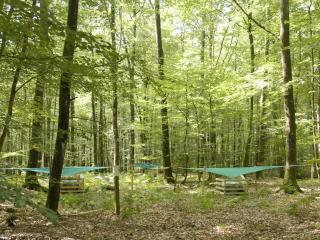Quantitative and Evolutionary Ecology of Communities Group
Members

Doctorante
UCBL

Professeure des universités
VetAgro-Sup
Tel: 33 04 72 43 27 56

Directeur de recherche
CNRS
Tel: 33 04 72 43 27 57

Doctorant
UCBL
Tel: 04 72 44 81 42

Doctorant
CNRS
Tel: 04 72 44 81 42
Doctorant
VetAgro-Sup

Maître de conférences
UCBL
Tel: 04 72 44 81 42
Doctorant
UCBL


Professeur des universités
UCBL
Tel: 33 04 72 43 27 56

Professeur des universités
UCBL

Directeur de recherche
CNRS
Tel: 33 04 72 43 27 56

Maîtresse de conférences
UCBL
Tel: 33 04 72 43 29 02
Maître de conférences
UCBL
Tel: 33 04 72 43 29 02

Our research activities, focused on interspecific interactions (community ecology), aim to better understand the ecological and evolutionary processes structuring species assemblages and biodiversity at different temporal and spatial scales. Our team addresses these major issues using contrasting biological models (communities of large African mammals, insects, microbiota, plants) from 3 complementary angles:
- Our work is strongly anchored in the conceptual framework of evolutionary biology by studying (i) the diversity of adaptive responses implemented by organisms to selective pressures in their environment, (ii) their consequences on population demography and ultimately (iii) the dynamics and composition of species communities.
- Our research is closely linked to societal issues of biodiversity conservation and management by integrating both the functioning of socio-ecological systems and the context of climate change. We conduct experimental studies, manage and ensure the long-term monitoring of several community observation networks.
- Methodological issues also occupy a central place in our team, with the development of new tools for statistical processing and modeling of ecological data. This activity leads to the development of methods and software that we develop and distribute freely.
Research programs

Functioning of African savanna communities
The Hwange LTSER (Long-Term Socio-Ecological Research site in Zimbabwe hosts a long-term interdisciplinary research program that focuses on the functioning of plant and animal communities within the Hwange National Park and the interactions between this protected area and humans living in its periphery. Based on this program, three axes are developed: (1) studying the population dynamics of elephants, exploring their impact and that of management policies on the socio-ecosystem functioning; (2) Understanding the extent to which interactions within and between trophic levels are sensitive to management actions (e.g. sport hunting, water management) and climate change; (3) Decoding human ecology and human-wildlife coexistence mechanisms towards integrated conservation and sustainable functioning of the socio-ecosystem. This research is complemented by more recent works in the Hluhluwe-iMfolozi Park and in the Madikwe reserve in South Africa, which focus on the role of environmental conditions on the hunting success of large African carnivores. We work in close collaboration with the IRL (International Research Lab) Rehabs.
Involved group members : Alice Bernard, Laura Lacomme, Aïssa Morin, Lisa Nicvert, Elie Pedarros, Yolan Richard, Marion Valeix*

Masting and the community dynamics of seed consumers
Masting is a reproductive strategy often encountered in perennial plants, characterized by fructifications highly fluctuating in time and being synchronized at the population level. The seeds produced that way constitute a pulsed resource with a strong impact on the eco-evolutionary dynamics of seed-consuming communities and forest regeneration. Our lack of knowledge of this system still impedes our understanding of the dynamics of temperate forest ecosystems and its future in the context of climate change. Our work carried out on oak forests aims to better understand (i) the proximal causes of masting, (ii) the mechanisms underlying the coexistence of species competing for such highly fluctuating resource and (iii) the co-evolution of consumer exploitation strategies for the fluctuating resource and forest tree fruiting strategies. On the basis of the results obtained, scenarii will be proposed on the future of forest regeneration under climate change, that may serve forest management.
Involved group members : Marie-Claude Bel-Venner*, Emilie Fleurot, Léa Keurinck, Jean Lobry, Samuel Venner

The spread of antibiotic resistance genes in bacteria
Antibiotic resistance is recognized as one of the greatest current threats to human health, and the mobile genetic elements (MGEs) that circulate in bacterial populations and communities are the main vehicles. To understand the dynamics and diversity of MGEs in bacterial pangenomes and the emergence of antibiotic resistance genes, we propose to go beyond the framework of conventional genomics by considering pangenomes as complex ecological communities. In the Ab-One program, we mobilize the concepts and tools developed in community ecology based on an integrative approach (monitoring of bacterial populations/communities evolving in contrasting environments -One-Health approaches-, pan-genomic analyses, experimentation in molecular and cellular microbiology, mathematical modelling). This program is currently focused on the dynamics of MGEs in Acinetobacter baumannii, an antibiotic-resistant microorganism classified as a priority by the WHO. Other more general approaches will illustrate the relevance of this new conceptual framework to understand the dynamics and diversity of MGEs in bacterial pangenomes. This program, co-piloted by our team and a team from CIRI (Horigene) involves the participation of 9 organizations (6 from Lyon -LBBE, CIRI, MMSB, HCL, LEM, VetAgro Sup-, Institut Pasteur (Paris), LMGM (Toulouse ), Robert Koch Institute (Germany)).
Involved group members : Stéphane Dray, Rémi Tuffet, Samuel Venner*

Statistical analysis of ecological data
Understanding the structure and dynamics of species assemblages, and the processes behind them, requires collecting data that are becoming increasingly complex owing to the sophisticated technological developments made available for their acquisition (e.g. GPS, loggers, satellite imagery, molecular data). We are developing new methods for analysing such data, that provide new insights into the ecological processes at work in communities. Multivariate analysis methods allow the analysis of spatial structures, accounting for various information on species (functional traits, morphology, phylogeny), the spatio-temporal variation of species-environment relationships or the multifaceted perception of the protected human-environment relationship. We also model multi-'omics' dose-response data within communities in order to better understand the Adverse Outcome Pathway (AOP) and to better appreciate the risks to the environment. These methodological innovations are made available to the scientific community through the development, distribution and maintenance of software (libraries for the R language: ade4, adegraphics, adephylo, ade4TkGUI, nlstools, fitdistrplus, DRomics, seqinr).
Involved group members: Marie Laure Delignette-Muller, Stéphane Dray*, Jean Lobry, Jean Thioulouse.
Publications
Display of 91 to 120 publications on 656 in total
The global spectrum of plant form and function: enhanced species-level trait dataset
Scientific Data . 9 ( 1 ) : 755
Journal article
see the publicationDeep learning in veterinary medicine, an approach based on CNN to detect pulmonary abnormalities from lateral thoracic radiographs in cats
Scientific Reports . 12 ( 1 ) : 11418
Journal article
see the publicationStrain- and serotype-dependent affinity of Shiga toxin-producing Escherichia coli for bovine milk fat globules
Journal of Dairy Science . 105 ( 11 ) : 8688-8704
Journal article
see the publicationAssessment of the French colistin action plan
Third International Conference AACTING: Quantification, Benchmarking and Stewardship of Veterinary Antimicrobial Usage .
Poster
see the publicationMeta-transcriptomics reveals stress adaptation processes in microbial communities differing in exposure history
"Ecology and Evolution: New perspectives and societal challenges" SFE2-GfÖ-EEF joint meeting, International conference on ecological sciences .
Conference paper
see the publicationMycobacterium tuberculosis genetic features associated with pulmonary tuberculosis severity
International Journal of Infectious Diseases . 125 : 74-83
Journal article
see the publicationInterpretation of the results of ELISA tests commercialized for the serological diagnosis of Coxiella burnetii infection in domestic ruminants: a user-friendly Shiny application based on latent class models in a Bayesian framework
31st WORLD BUIATRICS CONGRESS .
Conference paper
see the publicationEvaluation using latent class models of the diagnostic performances of three ELISA tests commercialized for the serological diagnosis of Coxiella burnetii infection in domestic ruminants
31st World Buitatrics congress .
Conference paper
see the publicationInterbacterial Transfer of Carbapenem Resistance and Large Antibiotic Resistance Islands by Natural Transformation in Pathogenic Acinetobacter
mBio . 13 ( 1 ) : e02631-21
Journal article
see the publicationUnravelling the environmental correlates influencing the seasonal biodiversity of aquatic Heteropteran assemblages in northern Africa
Limnologica . : 126021
Journal article
see the publicationEditorial: Advances in Statistical Ecology: New Methods and Software
Frontiers in Ecology and Evolution . 9
Journal article
see the publicationInterpretation of the results of Q fever ELISA tests in domestic ruminants : a user-friendly Shiny appli-cation based on latent class models in a Bayesian framework
ESCCAR International congress on Rickettsiae and 9th Meeting of the European Society for Chlamydia Research (ESCR) .
Conference paper
see the publicationEvaluation using latent class models of the diagnostic performances of three ELISA tests commercialized for the serological diagnosis of Coxiella burnetii infection in domestic ruminants
ESCCAR International congress on Rickettsiae and 9th Meeting of the European Society for Chlamydia Research (ESCR) . : #231
Poster
see the publicationCoxiella burnetii within- and between-herd true seroprevalence assessment in domestic ruminants in France accounting for diagnostic uncertainty with latent class
ESCCAR International congress on Rickettsiae and 9th Meeting of the European Society for Chlamydia Research (ESCR) . : #232
Poster
see the publicationAn appraisal of graph embeddings for comparing trophic network architectures
Methods in Ecology and Evolution . 13 ( 1 ) : 203-216
Journal article
see the publicationGenetic and species‐level biodiversity patterns are linked by demography and ecological opportunity
Evolution - International Journal of Organic Evolution . 76
DOI: 10.1111/evo.14407
Journal article
see the publicationIncertitude diagnostique des tests ELISA commercialisés pour le diagnostic sérologique des infections par C. burnetii chez les ruminants domestiques
Agrowebinaire organisé par Agreenium et Acta : Plateforme d'épidémiosurveillance en santé animale et zoonoses .
Conference paper
see the publicationA probabilistic approach based on latent class models to interpret Q fever serological test results at the individual and herd levels in domestic ruminants
Journée scientifique de l'Ecole Doctorale SVSAE .
Conference paper
see the publicationRebound in functional distinctiveness following warming and reduced fishing in the North Sea
Proceedings of the Royal Society B: Biological Sciences . 288 ( 1942 ) : 20201600
Journal article
see the publicationWhen more competitors means less harvested resource
Peer Community In Ecology . : 100088
Other publication
see the publicationPl@ntNet, ten years of automatic plant identification and monitoring
IUCN - Congrès mondial de la nature .
Poster
see the publicationThe dimensionality and structure of species trait spaces
Ecology Letters . 24 ( 9 ) : 1988-2009
DOI: 10.1111/ele.13778
Journal article
see the publicationDrivers of tree community assembly during tropical forest post-fire succession in anthropogenic savannas
Perspectives in Plant Ecology, Evolution and Systematics . 52 : 125630
Journal article
see the publicationUnveiling ecological assembly rules from commonalities in trait distributions
Ecology Letters . 24 ( 8 ) : 1668-1680
DOI: 10.1111/ele.13789
Journal article
see the publicationImprints of Past Habitat Area Reduction on Extant Taxonomic, Functional, and Phylogenetic Composition
Frontiers in Ecology and Evolution . 9
Journal article
see the publicationConvolutional neural networks improve species distribution modelling by capturing the spatial structure of the environment
PLoS Computational Biology . 17 ( 4 ) : e1008856
Journal article
see the publicationFunctional biogeography of weeds reveals how anthropogenic management blurs trait–climate relationships
Journal of Vegetation Science . 32 ( 2 ) : 1-12
DOI: 10.1111/jvs.12999
Journal article
see the publicationJointly estimating spatial sampling effort and habitat suitability for multiple species from opportunistic presence‐only data
Methods in Ecology and Evolution . 12 ( 5 ) : 933-945
Journal article
see the publicationHow Do Deep Convolutional SDM Trained on Satellite Images Unravel Vegetation Ecology ?
ICPR 2020 - 25th International Conference on Pattern Recognition . 12666 : 148-158
Conference paper
see the publicationDesigning sampling protocols for plant-pollinator interactions - timing, meteorology, flowering variations and failed captures matter
Botany Letters . 168 ( 3 ) : 324-332
Journal article
see the publication
You also, comment on this article